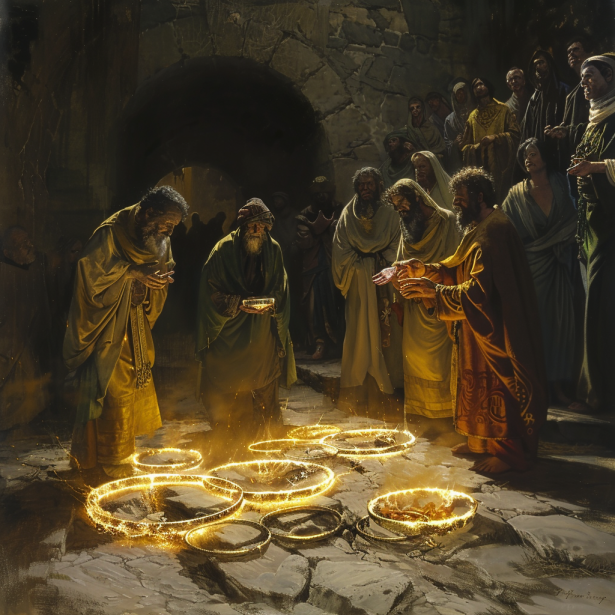Introduction
In the historic city of Ourense, Spain, there exists a captivating legend surrounding a set of ancient rings known as the ‘miracle’ rings. These rings, believed to possess miraculous healing powers, have been an integral part of local folklore for centuries. According to legend, the rings were blessed by Saint Martiño, the patron saint of Ourense, and have since been associated with curing ailments and bringing good fortune to those who wear them. Pilgrims and locals alike have sought out these rings, making them a symbol of faith and hope in the region. The true origins and the extent of their supposed powers remain a subject of mystery and devotion.
The Historical Context of Ourense
Ourense, a city with a rich history dating back to Roman times, is located in the northwestern part of Spain. Known for its thermal springs and historical architecture, Ourense is steeped in cultural and religious traditions. The legend of the ‘miracle’ rings is one of the many captivating stories that contribute to the city’s unique heritage.
The Legend of Saint Martiño
Saint Martiño, also known as Saint Martin of Tours, is the patron saint of Ourense. He is revered for his piety, humility, and numerous miracles. According to legend, Saint Martiño blessed a set of rings, endowing them with miraculous powers to heal the sick and bring good fortune. These rings have since been treasured as holy relics, attracting pilgrims seeking divine intervention.
The Miraculous Powers of the Rings
The ‘miracle’ rings are believed to possess a range of healing powers. Stories abound of individuals who, after wearing the rings, experienced cures from various ailments, including chronic pain, fever, and even paralysis. The rings are also said to bring good luck, protect against evil, and ensure safe journeys for travelers.
Pilgrimages and Rituals
Pilgrimages to Ourense to see the ‘miracle’ rings are a longstanding tradition. Devotees visit the Cathedral of Ourense, where the rings are believed to be kept, to pray and seek blessings. Special rituals, including prayers and the anointing of the sick with holy oil, often accompany these visits, enhancing the spiritual experience for pilgrims.
The Cathedral of Ourense: A Sacred Site
The Cathedral of Ourense, also known as the Cathedral of Saint Martiño, is a significant religious site in the city. It is said to house the ‘miracle’ rings, making it a focal point for pilgrims. The cathedral itself is an architectural marvel, with its Gothic and Romanesque features, adding to the mystical allure of the rings.
Folklore and Local Beliefs
Local folklore is rich with tales of the ‘miracle’ rings. Stories passed down through generations recount miraculous healings and divine interventions attributed to the rings. These tales reinforce the cultural significance of the rings and the deep-seated belief in their powers within the community.
Scientific and Skeptical Views
While the legend of the ‘miracle’ rings is widely cherished, there are also scientific and skeptical perspectives on their supposed powers. Some researchers argue that the reported healings could be attributed to the placebo effect or psychological factors. Despite this, the faith and traditions surrounding the rings remain undiminished.
Cultural Significance of the Rings
The ‘miracle’ rings are not just religious artifacts but also cultural symbols. They represent the intersection of faith, history, and community in Ourense. The rings have inspired local art, literature, and festivals, embedding themselves in the cultural fabric of the region.
Modern Day Pilgrimages and Tourism
Today, the legend of the ‘miracle’ rings continues to attract pilgrims and tourists to Ourense. The city’s rich history, combined with the allure of the rings, makes it a popular destination for those seeking spiritual solace or simply wishing to explore its cultural heritage.
Preservation of the Legend
Efforts to preserve the legend of the ‘miracle’ rings are evident in local traditions, festivals, and the continued veneration of Saint Martiño. These efforts ensure that the story remains a vibrant part of Ourense’s cultural identity.
Unanswered Questions and Continuing Mysteries
Despite extensive devotion and numerous accounts of miracles, the true origins and extent of the ‘miracle’ rings’ powers remain a subject of mystery. Questions about their creation, the exact nature of their blessings, and the historical accuracy of the legends continue to intrigue scholars and believers alike.
Conclusion
The legend of the ‘miracle’ rings of Ourense is a testament to the enduring power of faith and folklore. These ancient rings, believed to have been blessed by Saint Martiño, symbolize hope, healing, and divine intervention for countless individuals. As both a religious relic and a cultural treasure, the ‘miracle’ rings continue to inspire devotion and wonder in the hearts of those who seek their blessings.
FAQs
What are the ‘miracle’ rings of Ourense?
The ‘miracle’ rings of Ourense are a set of ancient rings believed to possess miraculous healing powers, blessed by Saint Martiño, the patron saint of Ourense.
Where are the ‘miracle’ rings kept?
The rings are believed to be housed in the Cathedral of Ourense, also known as the Cathedral of Saint Martiño.
What powers are the ‘miracle’ rings said to have?
The rings are said to cure various ailments, bring good luck, protect against evil, and ensure safe journeys.
Why do pilgrims visit Ourense?
Pilgrims visit Ourense to seek blessings from the ‘miracle’ rings, participate in rituals, and experience the spiritual and cultural heritage of the city.
What is the significance of Saint Martiño in the legend?
Saint Martiño is the patron saint of Ourense, revered for his miracles and believed to have blessed the ‘miracle’ rings, endowing them with their healing powers.
What are some modern views on the ‘miracle’ rings?
Modern views range from deep faith in the rings’ powers to skepticism, with some attributing reported healings to psychological effects like the placebo effect.

